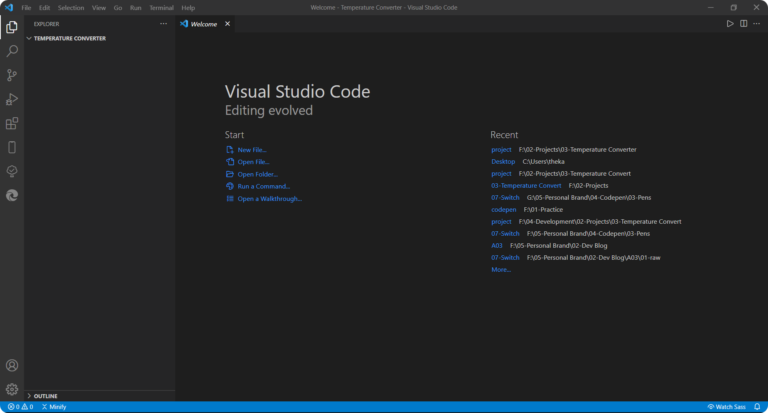Walmart.com has long been an extension of the popular brick-and-mortar Walmart stores, but it wasn’t until 2009 that the Walmart Marketplace launched. This opened up the Walmart.com platform to third-party sellers whose products complement the existing offerings from first-party brands.
Walmart Marketplace is now comprised of thousands of sellers, and it’s still growing. With dozens of categories spanning everything from fashion to electronics and much more, Walmart Marketplace is an effective sales channel for sellers both big and small in the United States.
As Walmart.com continues to grow (it saw 79% ecommerce growth in 2020) and online shopping becomes the norm for millions of Americans, a lot has changed since Walmart Marketplace’s inception. To learn everything you need to know about how to start selling on this online marketplace and how to get started, look no further than this blog post.
Ahead, you’ll find information about the registration process from start to finish, helpful insider tips and how to leverage integration partners to fuel success on Walmart.com.
Pros of Selling on Walmart Marketplace
1. Expand your reach.
With Walmart’s worldwide recognition and seemingly endless product categories, it’s no surprise that Walmart.com is a go-to shopping destination for many. The audience is currently more than 120 million monthly unique visitors, according to ComScore.
Leveraging this traffic is a huge advantage of selling on Walmart.com — you can get your products in front of an already established audience and unlock a whole new customer base on the site and the mobile app.
Plus, remember that Walmart Marketplace is a curated community of sellers. To get approved, you need to offer high-quality products priced competitively and provide top-notch customer service. What does that ultimately mean for you? With less competition, you get more visibility for your listings, and you’re in great company, selling alongside other professional sellers and Walmart’s first-party products.
2. Pay only for what you sell.
Let’s talk about pricing. Walmart is known for its low prices for customers, and that’s also true for its sellers. Walmart Marketplace uses a straightforward, simple pricing structure and charges no setup or monthly fees. Instead, the only cost is a reasonable referral fee on each completed purchase.
This fee varies by category (view a full breakdown here) but is typically 15%. That’s true for many categories, including apparel, beauty products and home & garden. Certain product categories, such as consumer electronics and cameras, have a lower referral fee of 8%.
3. Embrace innovation.
When you partner with a large retailer like Walmart, you get access to some of the most innovative ecommerce solutions — advanced listing quality tools, advertising options and expedited shipping programs that can organically boost conversion up to 50%, to name a few. You can see beneficial analytics up front to power your business decisions in the moment and in the future. We’ll explore more of these programs and tools later on.
How to Sell on Walmart Marketplace
Now that you’ve gotten a brief overview of what it’s like to sell on Walmart.com, you may be interested in how to apply to sell on Walmart Marketplace. Consider this your launch checklist.
1. The application process.
Requesting to sell on Walmart Marketplace consists of an application process that should take 10-15 minutes if you have the required information readily available. These requirements include:
Providing as much information about your business up front will save you time later. If you do have back-and-forth correspondence with Walmart Marketplace to fill any gaps in your application, it’s a good idea to act fast to avoid any delays in the review process.
2. Registration.
Once you’re approved to sell on Walmart.com, the next steps begin. You’ll first receive an email that contains the link to register your business, and the entire process of registration contains six steps, outlined below.
The Walmart Marketplace registration process:
- Account creation
- Walmart Retailer Agreement
- Company registration
- Tax forms
- Payment info
- Shipping info
Account creation
First, you’ll establish a username and password to rely on when managing your Walmart Marketplace seller account. Your username will be auto-filled based on the information you provided in your application.
You’ll use these credentials to log in to Seller Center, Walmart Marketplace’s portal for seller account management.
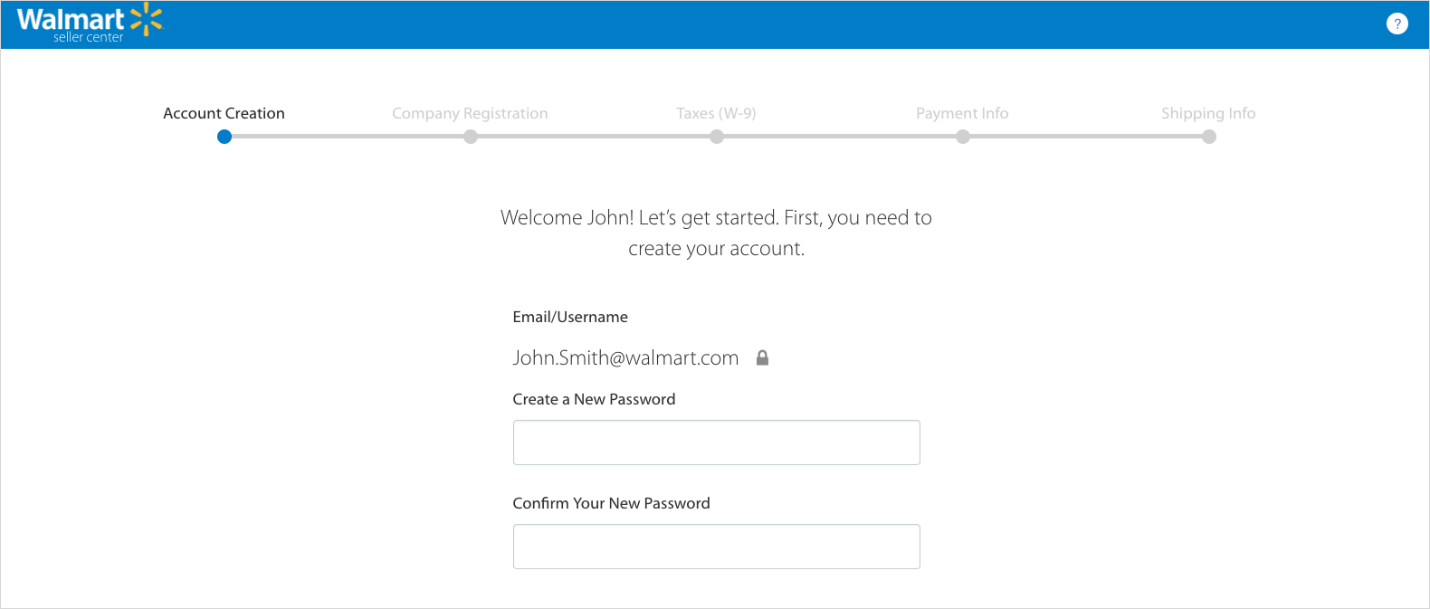

Walmart retailer agreement
Next, you’ll review the Walmart retailer agreement, a legal agreement that all Marketplace sellers sign. This document contains terms and conditions that sellers must accept before moving forward.
Company registration
As you get one step closer to making things official, you’ll register your company by entering a display name and a corporate address.
- Display Name: The name that appears to customers on Walmart.com.
- Corporate Address: The address used internally.
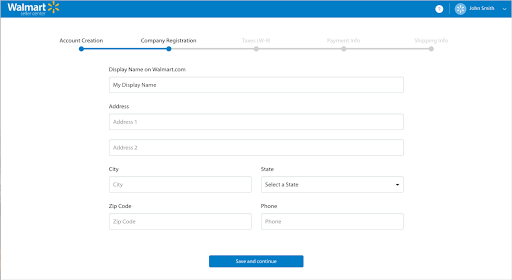

Tax forms
This step consists of filling out a W-9 form for tax purposes.
The required fields include your name, address and TIN (Taxpayer Identification Number).
Payment info
Walmart has partnered with Payoneer (Payoneer.com) and Hyperwallet (Hyperwallet.com) to process Marketplace partner payments, and you must register with Payoneer or Hyperwallet to receive your Walmart payments. Please note that only Payoneer is an available option for sellers with W-8ECI tax classification.
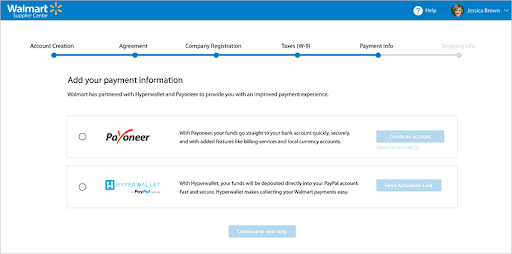

Shipping info
This is where you’ll select your shipping pricing model, shipping methods and the regions you’re able to ship to. Default shipping methods include Value, Standard, Expedited and Next Day.
After initial setup, you’ll be able to dig deeper into your shipping strategy by using Walmart Marketplace’s customizable Shipping Templates (more on those later).


3. List, test and go live.
The final step of onboarding as a Walmart Marketplace seller involves listing your catalog and testing orders before you officially go live. This process will ensure a smooth experience once customers are ready to add your items to their carts.
You should set up your top-selling items first, and remember that your items will go live once this testing is complete. For this reason, you should use real items with complete information and no indication that these are “test” items. If you have items belonging to multiple categories, provide a couple of items from each category for the initial round of item setup.
All of the items added successfully will automatically move to ‘stage’ status, which means that they won’t show up on Walmart.com until you go live.
Then test a few orders by publishing 2-3 items and placing your own test orders (no need to ship these). You’ll simply need to test the following scenarios in the Seller Center: order acknowledgement, order cancellation, order shipping and order refund.
Once everything is validated and working as expected, you are ready to go live on Walmart Marketplace! Walmart will complete a final review process and then will release your account to go live. Once you are live, your items are published to Walmart.com, transactable within a few hours and searchable in 24-48 hours.
Getting Started: Choose an Integration Method
There are multiple ways to manage your business and list your entire catalog on Walmart.com. If your company is capable of direct integration, you’ll add your items using either the API, Bulk Upload or a hybrid of the two.
If you need extra help, you can choose to work with a solution provider.
Walmart partners with leading solution providers that offer trusted support and a wide variety of ecommerce services. These include item setup, inventory, order fulfillment, pricing and more.
Some solution providers offer only specific functions, while others, such as Cedcommerce, offer full-service integration. Cedcommerce’s core capabilities include item setup, inventory management, order management, price management and a free 2-day shipping program via Deliverr.
Another great option is BigCommerce. Now that the company has partnered with Walmart Marketplace, sellers can easily manage their catalog and orders in one easily accessible portal using BigCommerce (learn more here).
Each integration is tailored to your specific needs, so you should reach out to your preferred solution providers directly to gather information on costs, features and capabilities.
To help you find the right fit, it’s a great idea to ask the following questions when evaluating a solution provider:
Do they offer:
- Item integration, including variation and swatch support?
- Order integration, including order cancellation, refunds and shipment services?
- Price integration, including price promotion and dynamic product repricing services?
- Inventory integration?
- Can they synchronize ecommerce data across multiple marketplace platforms?
- How much do they charge, including launch fees, setup fees and monthly support fees?
- What type of support do they offer (e.g., phone, email, chat)?
- What level of support do they offer (e.g., response time SLA, dedicated agents, etc.)?
Should you change your mind after selecting a solution provider for Walmart.com, you can switch to another one or opt to use direct integration instead. You should select the option that best suits your business’s needs. For more information, refer to the full list of Walmart-approved solution providers.
Seller Success: Explore Innovative Solutions Built to Help Sellers Thrive
Over the last couple of years, Walmart Marketplace has released a variety of innovative tools and programs designed with seller success in mind.
Once your products are live and available for purchase, you can continue optimizing your catalog and performance to grow your sales. We recommend paying attention to the following tools and programs:
- Check the health of your listings with the Unpublished Items Dashboard
- Optimize your listings with the Listing Quality Dashboard
- Win more customers with Expedited Shipping programs and services
- Take the stress out of returns with Enhanced Returns
- Stand out from competition with the Pro Seller Badge
- Advertise with sponsored products.
1. Check the health of your listings with the unpublished items dashboard.
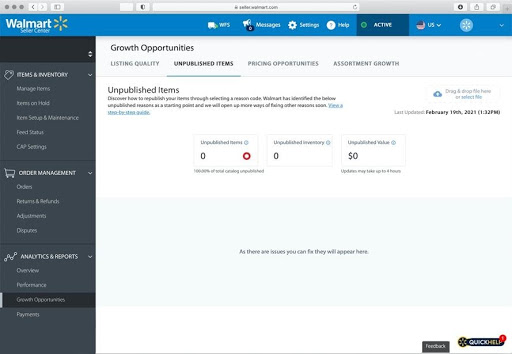

A unique tool in the Seller Center is the Unpublished Items Dashboard, which allows sellers to view and take action on items that have been unpublished. The dashboard provides detailed insights into select items that have been unpublished, the appropriate reason code for each, and step-by-step instructions you can take to republish them. Top reasons for items unpublishing can include issues like “Primary Image Missing” or an incorrect “End Date,” and the dashboard offers easy fixes.
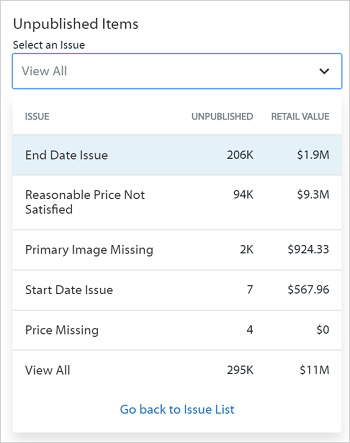

2. Optimize your listings with the listing quality dashboard.
Having good listings is the name of the game for any online seller on any website. But how can you really know how effective your listings are? Walmart Marketplace’s Listing Quality takes the guesswork out of this problem.
By taking a multifactor approach to analyzing listings, Walmart Marketplace created a sophisticated algorithm that results in a numerical Listing Quality Score. Reflected as a percentage, this score can range from 0-99 and appears at the item level and catalog level for each seller. It consists of four factors: content & discoverability, offer, ratings & reviews and post-purchase quality. To view and keep up with your Listing Quality Score at any time, visit the Listing Quality Dashboard in the Seller Center.
Here, you’ll not only be able to see your item and overall catalog scores, but you’ll also receive specific tips on how to improve your listings and attract more customers. For example according to Walmart data, the seller Big Red House increased its overall Listing Quality Score from 17 to 78 just two weeks after implementing tips found in the dashboard. By improving listings for its oven mitts, the company increased its reach and saw more sales.
“I used the Listing Quality Dashboard to quickly identify missed opportunities and shortcomings in my product listings,” Andrew Pancer from Big Red House told Walmart Marketplace. “The tool provided a great roadmap for me to make these improvements and the results have been significant.”
It’s not just about having the lowest prices—high-quality images, product descriptions, and competitive shipping options all play a part in good listings.
3. Win more customers with expedited shipping programs and services.
Satisfactory shipping and competitive shipping rates are at the heart of ecommerce success. Walmart Marketplace’s portfolio of expedited shipping options makes it easy for sellers to manage. When configuring your shipping settings, you can explore a variety of possibilities and choose what makes the most sense for your business.
The TwoDay program is ideal for both you and your customers. Items in your catalog that are able to keep up with 2-day delivery will benefit from eye-catching ‘free 2-day delivery’ tags on Walmart.com. These attract a lot of attention, increase Buy Box wins and drive more sales. In fact, sellers who participate on the two day program might see a 50% organic lift in conversion on average, according to Walmart data..
Another great option is the ThreeDay program. If you can’t afford to include free 2-day shipping for all of your items, 3-day shipping is the next best thing. Sellers see on average a 30% organic lift in conversion for items with a three-day delivery promise, according to Walmart data.
Shipping Templates:
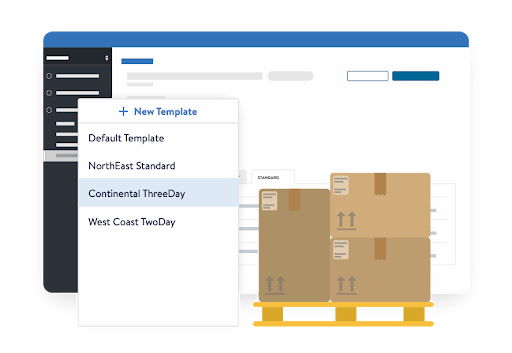

No matter how you choose to ship to various regions across the country, the best way to manage it all is with Shipping Templates. This recently launched tool, found in Seller Center, gives sellers the power to design custom templates to optimize their shipping strategy.
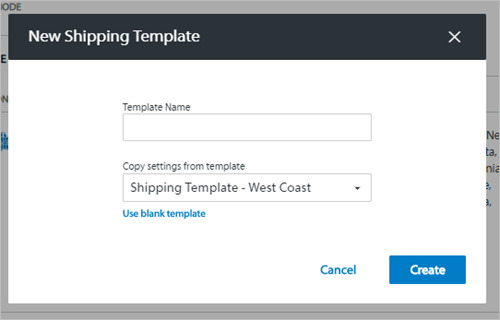

Sellers can create multiple easy-to-use Shipping Templates that include custom configurations, flexible transit times, granular delivery regions across the US and reports.
Let’s say you’re able to deliver quickly from a West Coast warehouse to adjacent states — you could create a West Coast Shipping Template, select TwoDay delivery and assign specific SKUs to this template as desired.
As another example, you could set up a template with Standard shipping, but with the transit time as flexible (it can be three, four, or five days). One template can have two shipping rules for “standard” delivery — one with a three-day transit time in certain regions close to your warehouse and another one with a five-day transit time for areas farther out.
Plus, selecting a three-day transit time for your Standard shipping method enables the ThreeDay Delivery program for your products and gives them a Buy Box boost on Walmart.com.
This template workflow provides a great way to see an overview of your shipping rules for your whole catalog, which may require different settings (if your assortment includes both small items and bulky items, for example). Quickly download reports to see which SKUs are assigned to each template.
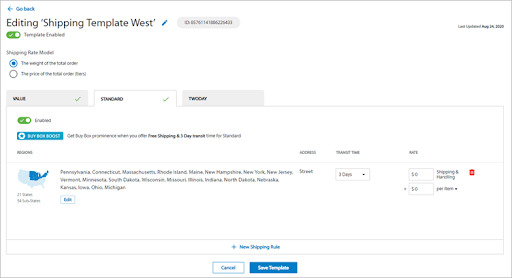

Get a more in-depth and visual overview of Shipping Templates in this QuickStart video tutorial.
Fulfillment solutions: WFS and Deliverr
Walmart Fulfillment Services (WFS) launched in 2020 as a low-cost fulfillment option for Marketplace sellers. WFS allows sellers to leverage Walmart’s advanced supply chain capabilities and leaves the picking, packing, and shipping all to Walmart.
Approved sellers can simply send their inventory to a WFS fulfillment center, where products are securely stored and prepared for shipping when orders are placed.
Learn more about WFS requirements and how to apply here.
Another fulfillment option for sellers is Deliverr, which integrates directly with the TwoDay program to guarantee fast shipping and boost item visibility. Deliverr stores your items close to your buyers so you can affordably offer fast shipping, and you pay a fixed fulfillment rate.
4. Take the stress out of returns with enhanced returns.
Walmart is uniquely positioned to allow customers to make returns both in stores and online. Known as the Enhanced Returns program for Walmart Marketplace sellers, this flexibility can increase customer satisfaction and also lower sellers’ costs. You can lower your return-processing costs when you choose Walmart’s Returns Shipping Service (RSS) as your preferred option for label printing. This in-store service gives you access to discounted rates and allows you to save on customer service and return fees.
5. Stand out from competition with the Pro Seller Badge.
Another recent Walmart Marketplace development is the introduction of the Pro Seller Badge.
While all Walmart Marketplace sellers go through a thorough vetting process and meet high standards to sell on Walmart.com, the Pro Seller Badge helps to drive attention to the best of the best products on the site.
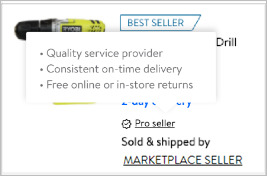

Products with the Pro Seller Badge offer quality customer service, consistent on-time delivery, and free online and in-store returns. This mark of excellence is displayed next to the “Sold & shipped by [Seller Name]” on Walmart.com, and customers can hover over the badge to see a short pop-up description about the criteria.
Criteria is refreshed twice every month, and Listing Quality is tied to eligibility — scores must be at least 50% for 60% or more of sellers’ trending items. Walmart Marketplace automatically grants (and takes away) badges according to the criteria, which can always be viewed in the Listing Quality Dashboard.
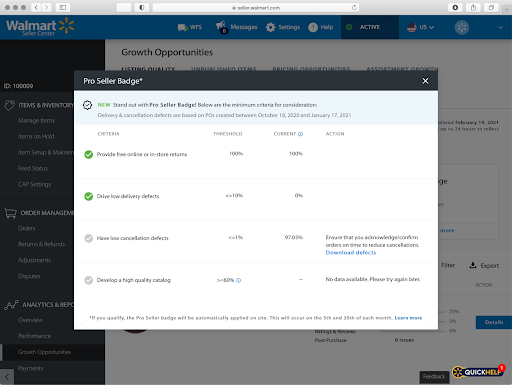

6. Advertise with sponsored products.
Walmart Marketplace offers its own CPC (cost-per-click) advertising platform that sellers can use to manage their own campaigns and budgets. The Sponsored Products tool increases visibility with ads that reach customers as they shop on Walmart.com, all the way from search to checkout.
Sellers can choose to leverage this service at any time, whether to reach holiday goals or to give certain inventory an extra push.
There are two types of campaigns: Automatic and Manual. Automatic campaigns allow the Walmart algorithm to serve ads against relevant search queries. Manual campaigns allow the seller to handpick keywords and bid on search queries that customers use to discover products on Walmart.com. Both methods are effective ways to drive impressions and purchases.
Summary and Helpful Resources for More Information
All in all, Walmart Marketplace is a great platform for anyone looking to expand their ecommerce business. The approval process is a selective one, but sellers with high-quality products and previous marketplace experience may want to apply.
Think you’ve got a better understanding of what it takes to become a seller? For additional resources with more information, check out the Sell Better Blog, Walmart Marketplace FAQs, and QuickStart Guides.



![Meta unveils a new large language model that can run on a single GPU [Updated]](https://whowillcare.net/wp-content/uploads/2023/02/meta-unveils-a-new-large-language-model-that-can-run-on-a-single-gpu-updated-768x432.jpg)

